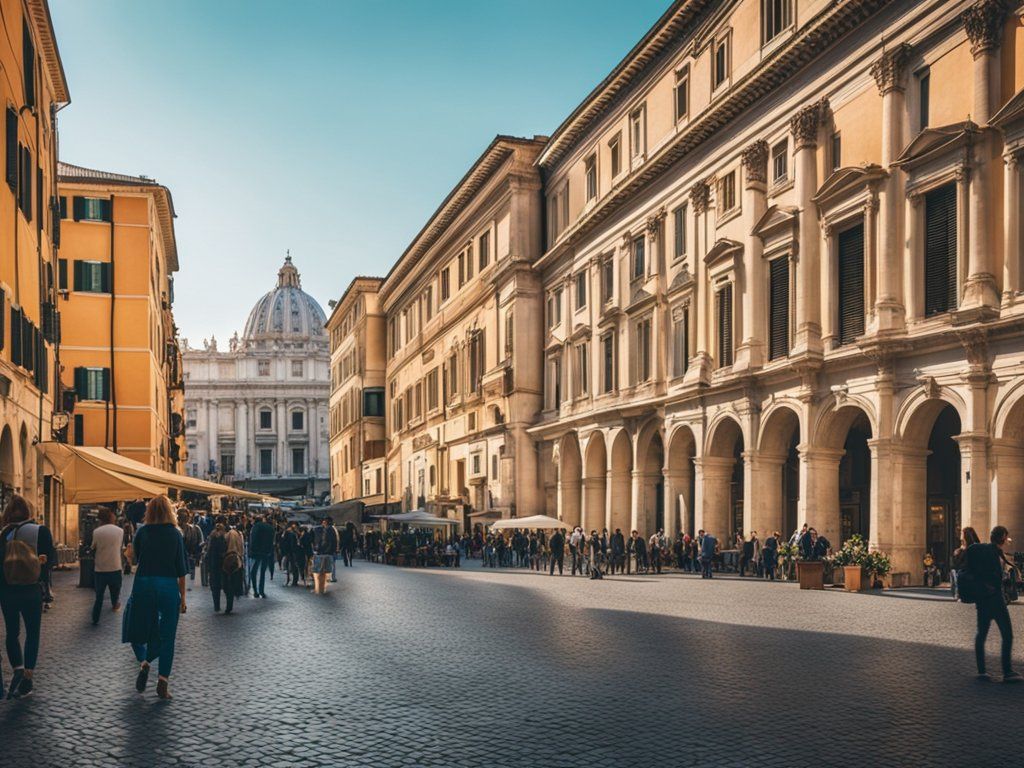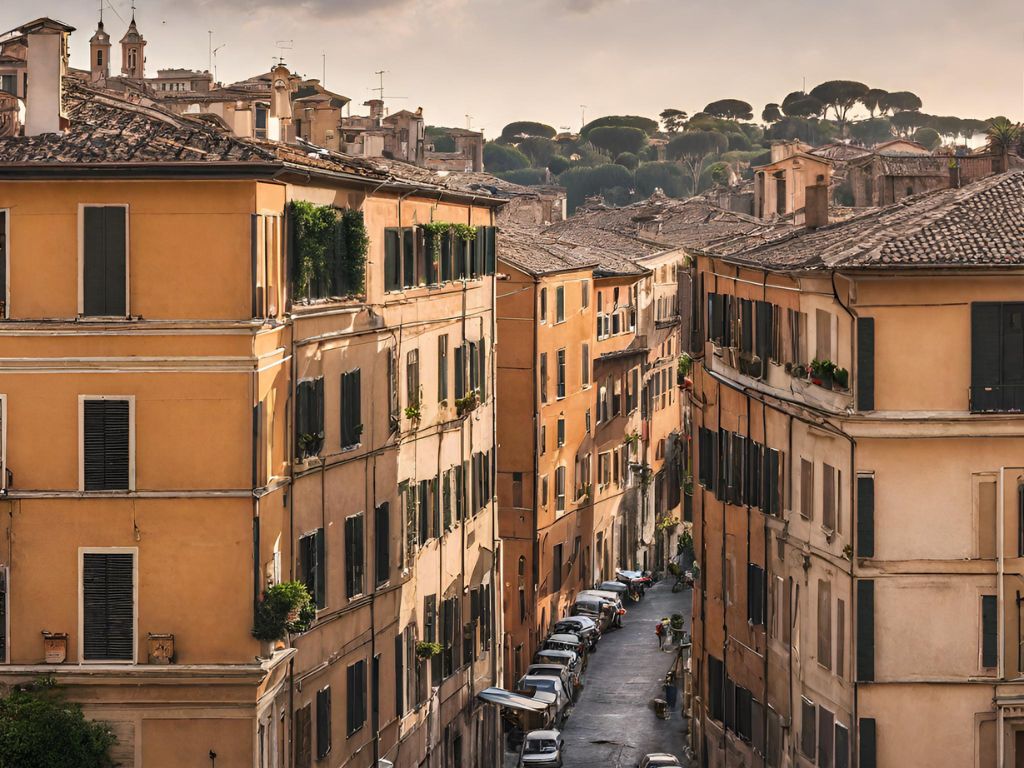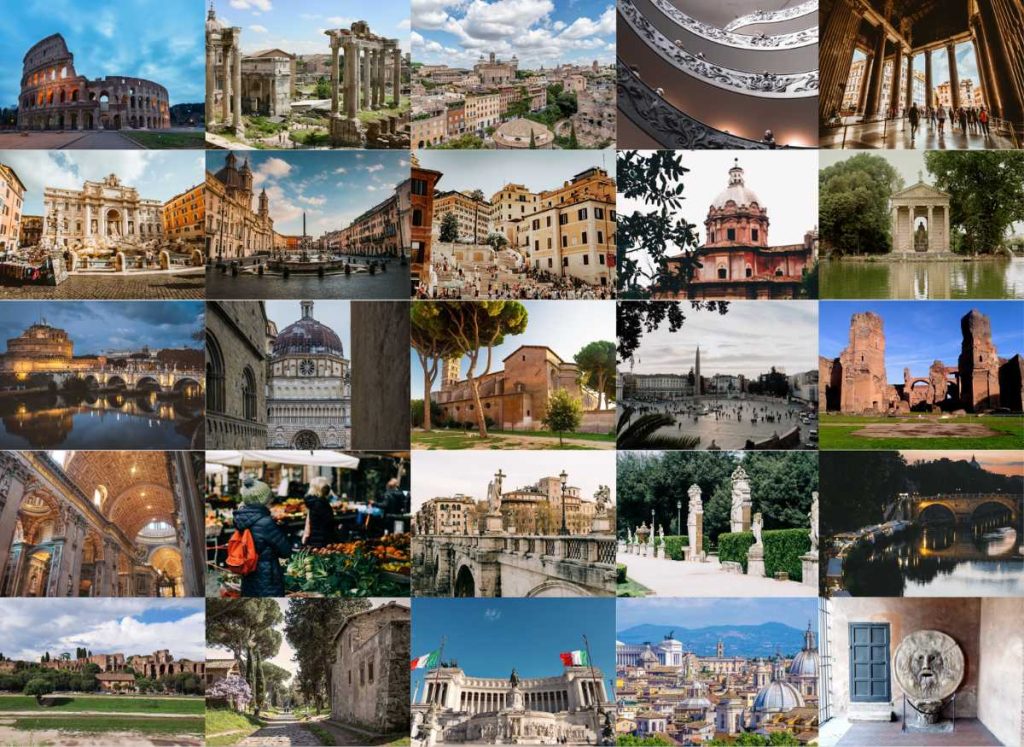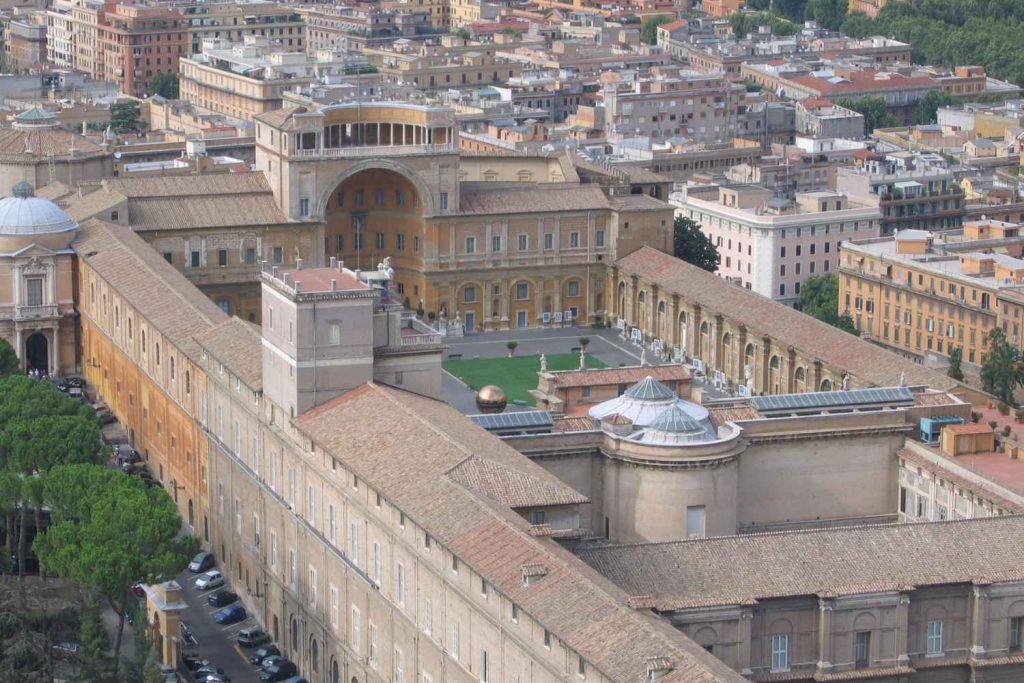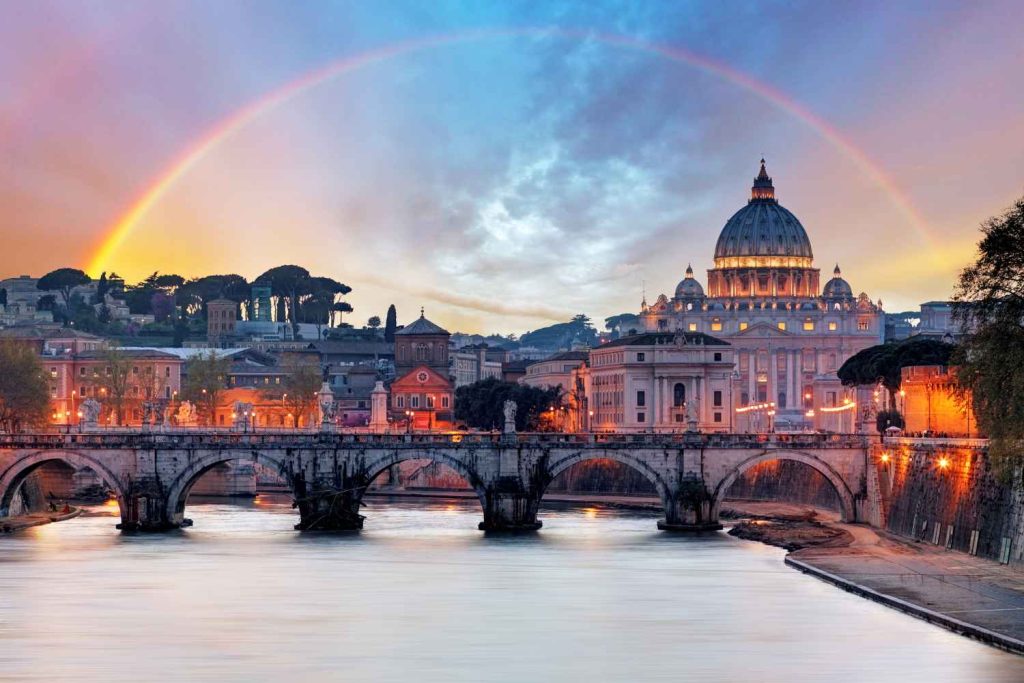The Renaissance in Rome was a period of remarkable cultural and artistic growth, spanning from the mid-15th to the mid-16th centuries.
This era witnessed the emergence of masters such as Michelangelo and Raphael, who left an indelible mark on Western figurative art. Rome, with its rich history and classical ruins, served as a magnet for artists eager to study and hone their craft in the city with a wealth of inspiration.
During this time, the arts flourished, with an emphasis on humanism, embracing ancient Roman and Greek traditions, and the revival of classical culture. The impact of Renaissance in Rome can be seen in various aspects of society, including architecture, literature, and the sciences. As a result, Rome evolved into a dynamic centre of creativity and learning, attracting artists, scholars, and patrons from across the continent.
In the realm of visual arts, the Renaissance in Rome saw the development of new artistic techniques and styles, allowing for the creation of awe-inspiring masterpieces. These innovations heavily influenced subsequent artistic movements and continue to inspire admiration and study today. The legacy of this extraordinary period in Rome’s history endures in the numerous artistic and architectural achievements that reflect the grandeur and ingenuity of the time.
Historical Overview
During the Middle Ages, Rome struggled to maintain its glory that it had acquired as the epicentre of the Roman Empire. However, this all changed with the Renaissance in Rome, a period of cultural, artistic, and intellectual rebirth in Europe, stretching from the 14th to the 17th century.
Rome played a significant role in the Renaissance due to its rich history and vast collection of classical ruins. Consequently, artists and scholars flocked to the Eternal City to study its masterpieces and immerse themselves in its heritage. Renowned architects and artists, such as Michelangelo and Raphael, significantly contributed to Rome’s artistic landscape during this period.
The Renaissance in Rome was different from other parts of Italy, like Florence, Venice, and Milan, which also experienced a cultural renaissance. While Florentine artists focused on linear perspective and naturalism, Roman artists were heavily influenced by their surroundings and sought to create an artistic fusion of classical antiquity and contemporary innovation.
Historically, Rome was at the centre of the Papacy, with Pope Martin V playing a crucial role in the revitalisation during the Renaissance in Rome. He initiated various construction projects and invited artists from all over Italy to work in Rome. Monuments that stand as a testament to the significance of the period include the Capitoline Hill, the Roman Forum, the Castel Sant’Angelo, the iconic Colosseum, and the Baths of Caracalla.
As the Renaissance movement continued to spread across Europe, Rome’s influence began to wane in the face of the Reformation, which sought to reform the Catholic Church. However, the Renaissance in Rome had already left an indelible mark on the artistic landscape of Europe and established the city as a prominent centre of culture and knowledge.
Renaissance Art
The Renaissance in Rome was a period of great artistic development and growth, as it saw the rise of masters such as Michelangelo and Raphael. These artists left an indelible mark on Western figurative art, with their notable works ranging from painting, sculpture, to architecture.
Among the most famous works of the Renaissance in Rome period, the Sistine Chapel holds a special place in the heart of the art world. Frescoes created by Michelangelo in the chapel are highly regarded masterpieces, showcasing the incredible skill and innovation of the time.
Leonardo da Vinci also contributed to the Renaissance. His iconic Mona Lisa is considered one of the most recognisable and representative works from that time period. Alongside da Vinci, Sandro Botticelli made a significant impact with his beautiful and innovative style, including the famous altarpiece of “The Adoration of the Magi”.
In terms of sculpture, Donatello was a pioneer in creating lifelike and expressive representations of the human form. His work on “David” is a prime example of early Renaissance sculpting techniques. Michelangelo would later sculpt his own David, resulting in a more detailed and dynamic artwork that has since become iconic.
During the Renaissance, artists continued to create exquisite Madonna and child depictions, attributing to the importance of religious art at that time. Works like Masaccio’s “The Holy Trinity” represented a mix of innovative composition, use of perspective, and technical skill, characteristic of the burgeoning movement.
As the period progressed, the artistic style of Mannerism began to emerge. This movement emphasised elongated forms, contorted poses, and artificial grace, diverging from the naturalism and realism of earlier Renaissance art. Artists like Tintoretto and El Greco found inspiration in this new trend, showcasing the ever-evolving evolution of artistic tastes throughout the Renaissance.
Visitors to Rome today can immerse themselves in the art and history of the Renaissance by experiencing the vast collections housed in the Vatican Museums. They can also admire the stunning Baroque sculptures and paintings at the Galleria Borghese, carrying with them the legacy of the Roman Renaissance.
Renaissance Architecture
The Renaissance was a period of significant cultural and artistic growth in Europe, and Rome played a central role in the development of Renaissance architecture. The revival of classical Roman forms is evident in many iconic buildings that emerged during this time. For example, the St Peter’s Basilica in Vatican City was one of the most influential examples of this architectural style.
Renaissance architecture was also characterised by the innovative ideas and groundbreaking techniques of famous architects like Filippo Brunelleschi and Leon Battista Alberti. Brunelleschi, best known for his work on the Florence Cathedral, introduced the concept of linear perspective, which revolutionised the design of buildings. Similarly, Alberti’s work, often seen in Santa Maria Maggiore, influenced the development of other famous monuments in Rome, such as the Pantheon.
Architect Bramante played a significant role in shaping the Renaissance architecture in Rome, particularly within the Vatican’s Apostolic Palace. His designs, often inspired by the classical ideals of proportion and geometry, were instrumental in creating a sense of grandeur within the palace and the surrounding Vatican walls.
During the Renaissance period, Rome was adorned with several piazzas, including the Piazza Navona, which exemplified the integration of art and urban planning. Bold sculptures, fountains, and artworks coexisted with public spaces to create a harmonious surrounding. One such artistic integration can be found at the Trevi Fountain, a masterpiece that showcases the perfect blend of architecture and sculpture.
In conclusion, Renaissance architecture in Rome was marked by a deep appreciation of classical forms, innovative design principles, and a harmonious union of art and urban spaces. From the majestic St Peter’s Basilica to the grand Apostolic Palace, the city’s architectural marvels continue to inspire and fascinate visitors from around the world.
Renaissance Literature and Philosophy
During the Renaissance in Rome, which spanned from the mid-15th to the mid-16th centuries, literature and philosophy saw significant developments. A crucial aspect of Renaissance philosophy was the improved access to previously unknown literature from ancient Greece and Rome. This period gave rise to notable philosophers such as Marsilio Ficino and Giovanni Pico della Mirandola as well as the flourishing of humanist philosophy.
One of the main features of Renaissance literature was the adoption of a humanist philosophy, which focused on the dignity and worth of the individual. This philosophical approach deviated from the dominant religious and scholastic traditions, placing emphasis on the study of classical texts. The recovery of classical Antiquity played a significant role in shaping the literature of this period.
A key literary figure during the Roman Renaissance was Francesco Petrarch, often referred to as the father of humanism. He was a scholar and poet who challenged medieval intellectual values, arguing for the study of classical scholarship. His works, written in both Latin and the vernacular Italian, inspired a new generation of writers to explore secular themes and produce literature in their native languages.
Another important philosopher was Marsilio Ficino, who translated numerous works of Plato, thus reviving Platonic thought in Europe. Ficino sought to reconcile Christian theology with this ancient wisdom, contributing greatly to the burgeoning spirit of humanism. His translations and commentaries significantly influenced both religious and secular thinking during the Renaissance.
The writings of Giovanni Pico della Mirandola, another outstanding philosopher in the Renaissance period, proposed that individuals have the capacity for self-determination and the ability to shape their destinies. His most famous work, the Oration on the Dignity of Man, expressed the notion that human beings have a unique position in the cosmos, bridging the material and spiritual realms. This work served to further strengthen the humanist stance in literature and philosophy.
Lorenzo Valla, an Italian scholar during the Renaissance, critically analysed and challenged accepted religious texts, introducing a new era of textual analysis. Through his work, he laid the groundwork for modern historical and critical scholarship. His contribution to humanist thought significantly impacted the progress of rigorous intellectual inquiry into classical languages, texts, and ideas.
In summary, the Roman Renaissance witnessed remarkable growth in literature and philosophy, marked by the adoption of humanist thought, the revival of classical texts, and the influential contributions of notable figures such as Petrarch, Ficino, Pico della Mirandola, and Valla. The period helped to shape the intellectual landscape of Europe for centuries to come.
Renaissance and the Papacy
The Renaissance period in Rome witnessed several transformations in the Papacy. This era is marked by the return of the Pope to Rome, following periods of papal residence in Avignon and the resolution of the Western Schism. One of the notable Popes during this time was Nicholas V, who commissioned the rebuilding of several landmarks in Rome.
Under his reign, and later that of Pope Julius II, the Papacy played a significant role in patronising Renaissance art and architecture. The Vatican Library and Apostolic Palace, which became symbols of wealth and power, were constructed during this period. This investment in art and culture contributed to shaping the image of Rome as a city of immense historical and religious significance.
The Papal States, governed by the Pope, underwent a transformation during the Renaissance as well. These states began to resemble a modern nation-state, with the Papacy taking a more active role in European wars and diplomacy. The influence of powerful families, such as the Borgia and Medici families, further contributed to the political landscape and the Papal States’ evolution.
The Counter-Reformation was another significant aspect of the Renaissance Papacy, as it aimed to counter the Protestant Reformation. This religious movement sought to address corruption within the Church, reform religious practices, and reaffirm traditional Catholic teachings. Some Counter-Reformation measures resulted in the strengthening of the Catholic Church’s influence, as observed in the construction of the Basilica di Santa Maria Maggiore, a symbol of faith and devotion.
In conclusion, the Renaissance period in Rome significantly impacted the Papacy and its role in the religious, cultural, and political landscapes. Through architectural masterpieces such as the Vatican Library and Apostolic Palace, Rome became a revered city in Europe, embodying the convergence of history and religion.
More articles you might like...
You can find more great Rome content in the following categories;
All about Vatican City Commonly Asked Rome Questions Rome Accommodation Rome Food and Drink Rome History and Culture Rome Neighbourhoods Rome Tours and Must-See Attractions
